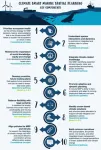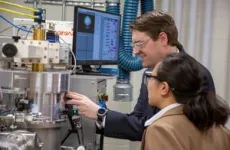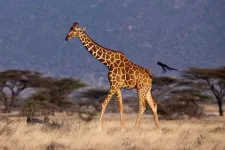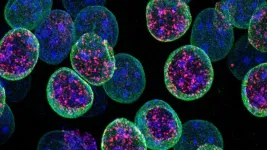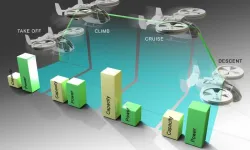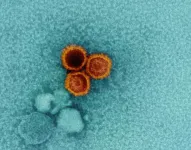(Press-News.org) New study identifies ten key components that will promote the development and implementation of sustainable, equitable, climate-smart ocean planning initiatives around the globe.
In a paper published March 12 in npj Ocean Sustainability, the researchers outlined guidelines to support marine managers and planners on how to develop climate-smart ocean plans and put them into action. Led by Catarina Frazão Santos, researcher and professor at the Faculty of Sciences of the University of Lisbon (Ciências ULisboa) and honorary research associate at the University of Oxford, the team included scientists and practitioners from both academia and international organizations, from Portugal, United States, Australia, Italy, Canada, Chile, South Africa, Brazil, and the United Kingdom.
The guidelines come at a critical time as UNESCO and the European Commission jointly launched a global marine spatial planning roadmap identifying climate-smart marine spatial planning as a key priority area for 2022–2027 – a need also highlighted by several other institutions, like the World Bank or the United Nations Global Compact. However, at a practical level, decision-makers and practitioners greatly need guidance on how to act.
“While marine spatial planning is being developed in over 75 countries all around the globe, to date no ocean plan has integrated climate change comprehensively,” says Catarina Frazão Santos. “With this Perspective, we aim to address this challenge and provide solutions to moving forward. The components are also intended to provide a checklist to support the assessment and monitoring of the level of ‘climate-smartness’ of existing and future marine spatial planning initiatives”, adds Catarina Frazão Santos.
Operational pathways and foundational principles
The proposed ten key components include foundational principles - underpinning the entire planning process- and operational pathways - practical channels to action. All are deeply interrelated and believed to function best as a coherent whole. However, the authors recognize that as components are context-dependent – that is, influenced by social, economic, political, and environmental factors -, in some cases some will be more prevalent than others.
Proposed operational pathways to developing climate-smart marine spatial planning ranged from integrating climate-related knowledge, to developing proactive future-looking plans, promoting adaptive and flexible planning, balancing flexibility with legal certainty, identifying ocean-based climate solutions, and building common narratives together with policymakers, the private sector, civil society, and other integrated ocean management stakeholders, to change perceptions of ocean sustainability and climate change.
At the same time, the authors advocate that several foundational principles are needed to unlock and support action. These relate to prioritizing ecosystem health as the primary strategy for marine spatial planning decision-making, understanding system interactions and dynamics to promote an integrated and systems view for ocean planning, reinforcing the importance of social knowledge, equity and change in co-developing sustainable ocean plans, and aligning marine spatial planning and climate policies to support the integration of climate change into marine spatial planning and ensure effective coordination among different policy arenas.
“We aim to foster further debate and advance a highly relevant topic for the future of our ocean,” says Catarina Frazão Santos, and adds:“The piece also comes at an important time as the marine spatial planning global initiative, by UNESCO and the European Commission, is expected to develop a guide on climate-smart marine spatial planning by late 2024.”
Quotes from co-authors:
“Climate is a game changer for marine planning, management and conservation. It moves the bar further away, making it more challenging to achieve ocean sustainability. This paper provides ten principles to set the course for a climate-smart approach to marine spatial planning.” Nathan Bennett, Global Oceans Lead Scientist, WWF & Chair of the People and the Ocean Specialist Group, IUCN
“Marine spatial planning is already complex in practice, and climate change only exacerbates these complexities. With this paper we have articulated real actions for ocean planners and managers to put into practice at a time when marine spatial planning cannot afford to be anything other than climate-smart!” Julie Reimer, Senior Policy Advisor, Fisheries and Oceans Canada
“Diving into climate-smart marine spatial planning is an important route to support climate justice and bring all coastal and ocean players into the process, ready to tackle the repercussions of climate change head-on. This paper brings concepts and down-to-earth steps to the table, helping countries and regions improve their planning and decision-making by putting climate at the heart of the action.” Marinez Scherer, Integrated Coastal Zona Management Coordinator, Ministry of the Environment and Climate Change, Brazil
“Operationalizing climate-smart ocean planning is a challenge we are all facing. As a scientist supporting a National Maritime Spatial Planning Process, I believe that the ten key components will help planners, practitioners, and scientists to work together for tailoring climate-smart marine spatial planning solutions for the benefit of communities and ecosystems.” Elena Gissi, Senior Scientist, National Research Council, Institute of Marine Sciences, Italy
“Marine spatial planning has been rapidly adopted as a new way of managing our seas. However, many marine spatial planning initiatives have not addressed the issue of climate change. These ten components provide a framework through which we can develop urgently needed climate-smart marine spatial planning in a forward-looking and equitable manner.” Wesley Flannery, Reader in Environmental Planning, Queen’s University Belfast, United Kingdom
“As countries face the enormous challenge of making good on their international commitments — including reaching UN Sustainable Development Goals, attaining targets under the Global Biodiversity Framework and the UNFCCC, and finding ways to safeguard the distant ocean in Areas Beyond National Jurisdiction — best practice guidance is badly needed. We highlight the basic principles forming the bedrock for action, and operational pathways to guide that action, to catalyse climate-smart marine planning across the globe.” Tundi Agardy, Sound Seas, United States
“Mainstreaming climate change into marine spatial planning presents great challenges, such as the uncertainty associated with climate projections and the complexity of considering impacts across different sectors. However, this integration also offers opportunities to promote the resilience of coastal communities, protect vulnerable ecosystems, and foster innovation in the sustainable use of marine resources by designing more realistic scenarios. Climate proofing marine spatial planning must go beyond the stage of generalist proposals and start launching effective good practices that can be tailored into each specific framework.” Helena Calado, University of the Azores, School of Science and Technology, Portugal
END
Scientists propose ten key components to foster climate-smart marine spatial planning globally
2024-03-12
ELSE PRESS RELEASES FROM THIS DATE:
UC Irvine study: vehicle brakes produce charged particles that may harm public health
2024-03-12
Irvine, Calif., March 12, 2024 — Scientists know relatively little about particles released into the air when a vehicle driver brakes, though evidence suggests those particles may be more harmful to health than particles exiting the tailpipe.
In a new study in Proceedings of the National Academy of Sciences, University of California, Irvine researchers show how most of these particles emitted during light braking carry an electric charge – something that could potentially be ...
Aston University to train the UK’s next generation of decarbonization experts
2024-03-12
Consortium led by the University is to receive almost £11 million to open doctoral training centre
Will focus on use of biomass to replace fossil fuels and removal of CO2
“…part of the UK’s biggest-ever investment in engineering and physical sciences doctoral skills”.
Aston University is to train the next generation of scientists tasked to remove greenhouse gases from the environment.
A consortium led by the University is to receive almost £11 million to open a doctoral ...
Gene flow in giraffes and what it means for their conservation
2024-03-12
Giraffes are a beautiful and powerful example of what adaptive evolution can achieve. However, in recent years they have attained notoriety for a completely different reason: it has been suggested that instead of one giraffe species, there might be no fewer than four different species. Such dramatic taxonomic reappraisals in highly conspicuous and well-known “flagship” taxa are very unusual. The suggestion caused some uproar in the scientific community and received a lot of media attention. Much is at stake, because the way that most nature conservation works is focused on species, meaning that each species must receive its own dedicated conservation action plan and must ...
Study reveals the role of the protein Kdm1a in maintaining neuronal identity
2024-03-12
Epigenetic processes allow different cell types to emerge from a single genome. Throughout development, cells differentiate and acquire distinct characteristics by expressing the same genome in different ways. However, a less-known aspect of this process is how cells maintain their unique identities over time. A study led by the Transcriptional and Epigenetic Mechanisms of Neuronal Plasticity laboratory, headed by Angel Barco at the Institute for Neurosciences, a joint center of the Spanish National Research Council (CSIC) and the Miguel Hernández University (UMH) of Elche, has determined that the protein Kdm1a plays ...
UT Arlington grad student earns fellowship from atomic energy agency
2024-03-12
The International Atomic Energy Agency (IAEA) has awarded a prestigious fellowship aimed at encouraging women to study nuclear-related subjects to a University of Texas at Arlington graduate student researching isotope hydrology.
Suprina Shrestha, a master’s student in earth and environmental sciences, received a Marie Sklodowska-Curie Fellowship (MSCF) from the IAEA. She studies tracer hydrology, which is the use of natural and artificial tracers to examine hydrological processes, under the mentorship of Ricardo Sanchez-Murillo, associate professor of ...
More than flying cars
2024-03-12
Researchers at the Department of Energy’s Oak Ridge National Laboratory are taking cleaner transportation to the skies by creating and evaluating new batteries for airborne electric vehicles that take off and land vertically.
These aircraft, commonly called eVTOLs, range from delivery drones to urban air taxis. They are designed to rise into the air like a helicopter and fly using wing-borne lift like an airplane. Compared with helicopters, eVTOLs generally use more rotors spinning at a lower speed, making them both safer and quieter.
The ...
Centre for Doctoral Training in Diversity in Data Visualization awarded over £9m funding from the EPSRC
2024-03-12
Announced today, a new Centre for Doctoral Training (CDT) has been funded by a grant of over £9 million from the Engineering and Physical Sciences Research Council (EPSRC) to help train the next, diverse generation of research leaders in data visualization.
A collaboration between City, University of London and the University of Warwick, the EPSRC Centre for Doctoral Training in Diversity in Data Visualization (DIVERSE CDT) will train 60 PhD students, in cohorts of 12 students, beginning in October 2025. The set-up phase will begin in July 2024.
The funding announcement is part of a wider UK Research & Innovation (UKRI) announcement of ...
NIH scientists find weak points on Epstein-Barr virus
2024-03-12
WHAT:
Studies of interactions between two lab-generated monoclonal antibodies (mAbs) and an essential Epstein-Barr virus (EBV) protein have uncovered targets that could be exploited in designing treatments and vaccines for this extremely common virus. The research was led by Jeffrey I. Cohen, M.D., and colleagues from the National Institute of Allergy and Infectious Diseases (NIAID), part of the National Institutes of Health. Study findings were published in the journal Immunity.
Approximately 95% of the world’s population is infected with EBV, which remains in the body permanently, typically ...
Spiral wrappers switch nanotubes from conductors to semiconductors and back
2024-03-12
DURHAM, N.C. -- It might look like a roll of chicken wire, but this tiny cylinder of carbon atoms -- too small to see with the naked eye -- could one day be used for making electronic devices ranging from night vision goggles and motion detectors to more efficient solar cells, thanks to techniques developed by researchers at Duke University.
First discovered in the early 1990s, carbon nanotubes are made from single sheets of carbon atoms rolled up like a straw.
Carbon isn’t exactly a newfangled material. All life on Earth is based on carbon. ...
Researchers identify distinct sleep types and their impact on long-term health
2024-03-12
UNIVERSITY PARK, Pa. — Poor sleep habits are strongly associated with long-term chronic health conditions, according to decades of research. To better understand this relationship, a team led by researchers in Penn State’s College of Health and Human Development identified four distinct patterns that characterize how most people sleep. These patterns are also predictive of long-term health, the researchers said.
Soomi Lee, associate professor of human development and family studies at Penn State, ...
